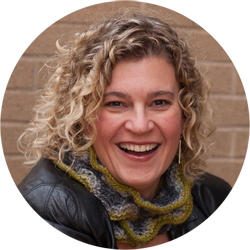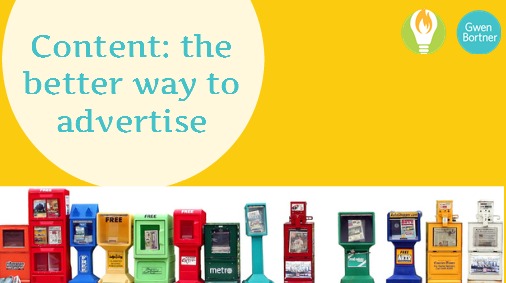
by Gwen Bortner | Abundance, Marketing
One of the things I love most about reading business books is that I don’t always have to invent brand-new ideas for my business; instead, I can find great ideas in the pages of these books. Starting in April, I’ll be leading a book study of Brandscaping by Andrew M. Davis for the Small Biz Book Club, so today I wanted to share an example of how this book gave me a great idea.
Of course, you already know that I got the idea for the entire book club from Brandscaping, but that wasn’t the only gem I found when I read it. I was actually able to get an idea to help one of my consulting clients, too! Here’s how:
Advertising: Worth it or not?
My client and I were discussing an opportunity she had to advertise in a local community magazine (this client runs a brick and mortar craft supply shop). The advertising cost was somewhat steep, but she felt it might help her generate some local business for her shop. After all, that is often our go-to place to drum up business, right? Advertising. However, that doesn’t mean it’s always the best option.
Since I had read Brandscaping, I knew that advertising only gets you so far: a little bit of exposure in a single publication. Let’s be honest – how often do you actually read the ads in a magazine, instead of just skimming over them to get to the content?
Don’t advertise – Brandscape
With that in mind, I suggested to my client that instead of paying for an ad, she pitch herself to the magazine editor as a prospective contributor.
I told my client that she could write regular articles for this publication, centered around a topic that would be of interest to the local readers and help to promote her shop. (In this case, the topic was home decor tips using handmade projects, for which the readers could come to her shop to purchase supplies.) This is a win-win scenario, because the magazine editor gets regular, fresh content for her publication and the shop owner gets free advertising (heck, the magazine might even pay her to write the pieces!).
Share the Love
I told my client that if she was worried about generating enough content for regular publication, she could extend the “brandscape” even further by inviting a few other shop owners to contribute to the column as well. They could team up and divide the work so no one would have to find the time and inspiration to write one article every time the magazine was published. As long as she chose shop owners who could also write about the general topic without directly competing with her for business, this would be a great way to take some of the pressure off of her and add a few more networking relationships with other small business owners.
If I hadn’t read Brandscaping, I never would have had this idea. What will be the next great idea YOU have for your business? Will you find it in a book?
If you’d like to read Brandscaping and get a FREE weekly study guide to help you stay on track and apply the material to your small business, sign up below to be notified when the study guide goes live. It’s entirely free, and I hope to see you in the club!

by Gwen Bortner | Book Review

by Gwen Bortner | Book Review

by Gwen Bortner | Marketing
Last summer, a professional colleague of mine approached me and asked me to consider serving as the interim Executive Director for The National Needlearts Association (TNNA – the trade organization for needle arts professionals). Now that I’ve concluded my work in that position, looking back I can say it was the perfect job for me. The thing is, I didn’t know that until they asked me to do the job. It’s an opportunity I easily could have missed, but I didn’t because I had been preparing for it for years.
Open to Opportunity
Ultimately, landing this job was a result of good sales; except I didn’t have to “sell myself” in the moment as a candidate for the position, because I had marketed myself so well up to that point that the TNNA president thought of me when the position became available. Instead of having to compete with other equally well-qualified candidates, I set myself up as the “natural choice” for the job, just by establishing relationships with my fellow board members within the organization.
Non-salesy Marketing
When you can say to someone, I know you, I’ve worked with you, we have a relationship, that lays the foundation for future collaborations. The best opportunities often come from the relationships we form. Think about how many times you’ve found out about a great deal because your best friend told you about the sale, or how many times you’ve been recommended by someone else and that has helped you move forward in your career. Thinking about it this way makes it clear: it’s just as important to spend time forming professional relationships with other people as it is to work on improving your own skills and advancing your own career.
You don’t always have to keep the end goal in mind.
This job at TNNA was never on my bucket list, but it was an amazing opportunity that came up, and I took it. If you do have an end goal, great, but you don’t have to! Sometimes you don’t know what opportunities might come down the line as the result of forming a relationship with someone else, and sometimes they won’t come at all. But it’s always a good idea to establish yourself as an expert and a team player.
Working at TNNA lined up easily with all of my personal and professional goals, so it was an ideal fit for me at that time in my life, even though at the time I was focused on other projects and didn’t have a job like this lined up in my sights.
Keep surprising them
In the recent past I have worked hard to establish myself at TNNA not just as a knitter, but as a businessperson. I have transitioned away from teaching knitting classes and instead I offer business classes to the members at our annual shows. I served on the board and I brought my best “business game” with me to every meeting. In doing so, I set myself up as the natural choice to lead the organization when the former Executive Director stepped down, even though leading the organization wasn’t specifically one of my goals.
If I had focused on showcasing my work as a knitting instructor only, I probably would have continued to grow my knitting business through TNNA, but ultimately that wasn’t my goal. By putting myself out there as a business consultant and taking opportunities to showcase that skill set, I was able to further my own goals and those of the organization as a whole.
Lessons in Creative Marketing
To wrap up, here are the take-aways I hope you learn from this post:
- Put yourself in the position, whenever possible, to make relationships with people who will notice your presence and begin to feel like they know you.
- Focus as much on building relationships with others in your field (and in the professional world in general) as you do on building your own skills.
- Look for opportunities to network and connect with other people. Join a trade organization, a local board, or a leadership club.
- Showcase all your skills, especially those you want to focus on professionally, at every opportunity.
- Be open to opportunities everywhere; you never know when you’re going to find the best job you never knew you always wanted!
If you enjoyed this post and learned something from it, please take a moment to share it!
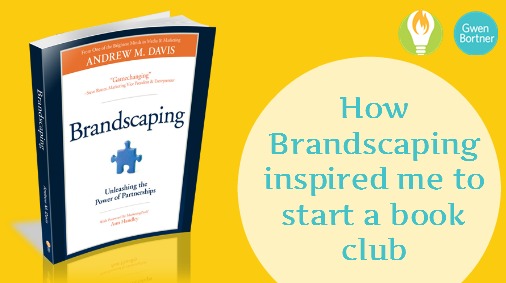
by Gwen Bortner | Marketing
Starting in April, I’ll be facilitating a read-along study of Brandscaping, by Andrew M. Davis. Reading this book earlier in 2016 actually inspired me to start this new venture: the Small Biz Book Club.
Content is King
One of the main concepts in Brandscaping is that you should find ways to connect with your audience members through high quality content. An add-on tip to this idea is that YOU don’t have to be the person who creates that content; there’s no need to reinvent the wheel if good content already exists that would be interesting to your audience. The key is to find ways to leverage that existing content in ways that will be useful to your readers.
Serving my Audience
Inspired by that idea, I started to think about the content that already exists that would appeal to small business owners. I realized that the book I was reading was an example of that content – as were the other business books I had read. There’s a wealth of information available to small business owners within the pages of books, but many small business owners don’t take the time to read them.
Big Concepts for Small Business
I realized that for some small business owners, reading a business book was overwhelming, because in general the “big name” business books are written for bigger businesses. They might discuss scenarios from businesses like Wal-Mart or Ford, and if your business is nowhere near that size then it feels like those scenarios don’t apply to you. Boiling down these big ideas into applicable steps and tips for small businesses is something that comes easily to me, so I realized that if I could facilitate that process for other small business owners, it would be a way to help them apply the lessons in business books to their own experiences.
And thus, the Small Biz Book Club was born.
I talked to my assistant and we determined the format: weekly lessons delivered for free on my website or via email, which would provide insights and guidance to help make it easier to read these business books and get something out of them for your small business. We’ll include the option to join a private Facebook group for further discussion, to really get into the details of how to apply the lessons we’re learning. And then when we’re finished with a book, we’ll package up all of those lessons into a downloadable study guide for anyone who wants to read the book again or anyone who missed the first read-along.
If you’d like to read more business books AND actually apply the lessons from them to your small business, I’d love for you to join us for the Small Biz Book Club. We’ve got two options:
- Sign up to read along with Brandscaping, by Andrew M. Davis. Click here to read more about that, and join us for the read-along study if you like what you see. You’ll also have the option to sign up to be notified, just once a month, of the other books we’ll be reading. You’ll have the option to join in on any of the read-alongs, or sit them out.
- If you aren’t interested in Brandscaping but you still want to be notified about the Small Biz Book Club activities and have the option to read along with future books, enter your email address into the box below. You’ll get one email per month introducing you to the next book we’ll be reading, and if you choose to read along then you can do so by visiting my website or by signing up for weekly email reminders for that book only. Any month you may choose not to read along with us, and you won’t hear from me again until the following month when there’s a new book.
I hope you’ll consider joining us for the book club!
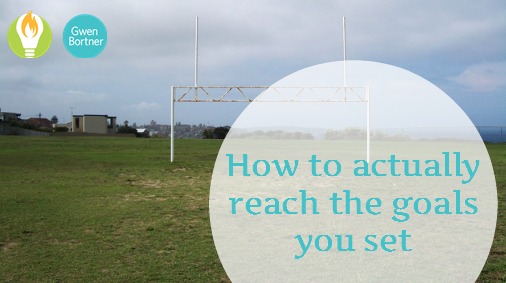
by Gwen Bortner | Tasks & Goals
Setting goals is great – it feels so good to think about the future and make plans for the greatness you will achieve in the coming year. The hard part comes when you start looking back at the goals you set, and you realize you haven’t met any of them. Stop letting yourself down – learn how to actually MEET the goals you set so that you don’t have to feel like a failure any more!
Here are my best tips for achieving the goals you set for yourself, whether they’re for life or business or both!
Tip #1: Understand whether or not this goal REALLY matters to you.
Often when we fail to reach a goal, it’s because we gave them lip service but weren’t truly inspired to reach them. We thought we should set the goal but as it turns out, we don’t want to actually work with it. So the first step is to eliminate all the goals that don’t actually matter. Though this may *feel* a bit like failing at those goals, in reality it’s more like de-cluttering your goal list so you can focus on working towards the things that matter most.
Tip #2: Keep your goal count low.
When you set too many goals at once, you’re focusing on too many things and you don’t get any progress made. Even if you have several goals in mind, choose just a few to focus on at any one time so that you can make real progress. It’s better to check off your goals one at a time because you can use that progress to motivate you to work toward the next goal, rather than pushing yourself to work on too many projects at once and feeling like you’re never going to finish anything.
Tip #3: Partner with someone who has similar goals.
This type of relationship is called an accountability partner, and it can be really helpful to work together with someone who has similar goals to your own. The concept is most familiar in the form of a workout buddy but it can be applied to any goal. The key is to work toward supporting one another and not turn it into a competition.
Tip #4: Work with someone who can help to push you toward reaching your goal.
Instead of an accountability partner (someone who has a similar goal), this tip is more about finding an outside person to motivate you to work on your goal. It might be a partner or friend or it could be someone like a business consultant or coach.
Tip #5: Set 3-Level Goals.
Todd Herman suggests you should give yourself goals at 3 levels: good, better, best. For instance: the best-case scenario is that you want to lose 50 pounds, but good would be 10 and better is 25. If you ONLY set the highest-level goal then it often takes too long to reach it and it’s easy to get discouraged. But when you reach the good or better goal then that can even be what motivates you to push to the next level.
Tip #6: Look for the WOW Mindset.
Instead of looking at how far you have to go, you look at how far you have already come. Instead of, “I’ve still got 9lbs to lose,” think of it like, “WOW, I lost a pound already!” Looking at your goals from the mindset of the progress you’ve made rather than what’s left to do is a way to encourage yourself to keep making that progress. (This is another of Todd Herman’s great ideas!)
Tip #7: Avoid the OW Mindset.
Herman’s final contribution to this post is the “OW Mindset,” or the idea that all too often we focus on what’s left to come instead of on how far we have already climbed. This tip is the companion to the last one; avoid thinking of the “pain” of what’s to come and instead focus on the success of what you’ve already achieved.
Tip #8: Recommit to your goals on a regular basis.
Review your progress, make adjustments as needed, and keep moving forward. This is the foundation of making actual progress – the process of checking up on the progress you’ve made and reminding yourself why you wanted to achieve that goal in the first place.
Every quarter I host a group session to help you to do these things – review and plan. Read more about the Quarterly Tune-Up here. Click the Register Now link if you are interested.
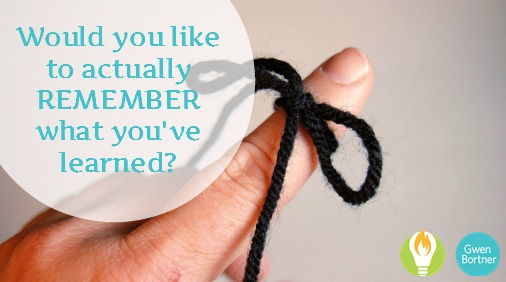
by Gwen Bortner | Tips & Tricks
Have you ever had that sensation that you know something, but you can’t quite access the information in your memory banks? We’ve all been there, and it can be super frustrating. If you’d like to improve the way you retain & recall information, keep reading for three useful tips.
Know yourself and which method works the best for you.
Look at your history and try to remember the times that were easiest for you to learn something new. Maybe you took a class and picked up the new technique right away, or you read a book and really understood the material without any additional help.
Take note of not only how you took in the information (was it a live class, a 1-on-1 conversation, or an independent study?), but the rest of the details as well, such as the time of day or the environment around you. Now, seek out new opportunities to learn in a similar environment and using a similar method.
Pro tip: It also depends on the type of knowledge you’re looking for – reading about how to ski is not going to be nearly as practical as actually getting on some skis, but if reading is how you learn best then you can still do some research ahead of time!
Apply the knowledge as soon as possible.
The sooner you make use of the knowledge you’ve gained, the more likely it is to “stick.” If you’ve learned a new technique or skill, go home and practice it after class. If you’ve read something interesting, write a blog post or journal entry about it. Even if it’s just a “fun fact,” you can apply it by finding opportunities to share it with two or three other people within a week!
Share it with others.
One of the best ways to become an expert at something is to teach it to others. Engage in discussion, teach someone else what you just learned, or tell your employees about what you’ve learned so they can help you apply it to your business. Find ways to share your knowledge and you’ll find it’s much easier to remember!
Do you want to get more out of the information you read in books? Join our Small Biz Book Club so you can get weekly updates, reading prompts, and questions and tips to actually apply what you’re reading and put it to work in YOUR small business!


